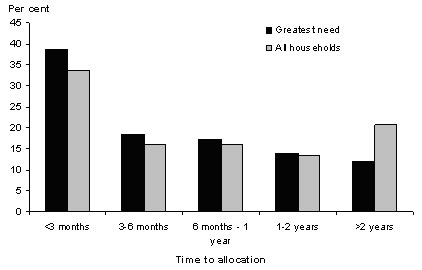Summary
Over 11,500 households were living in state owned and managed Indigenous housing at 30 June 2009, occupying 95% of all SOMIH dwellings. Of these households, 84% paid less than market rent for the dwelling. On average, SOMIH rebated households paid about $123 per week less than the market rent for their dwelling. The remaining 16% of households paid market rent.
During the period 1 July 2008 to 30 June 2009, about 1,100 households were newly assisted with SOMIH housing. Of the households for which adequate details were known, approximately half (49%) were classified as being in ‘greatest need’. 1
Figure 2 represents the proportion of new allocations by time since application for greatest need households and all households, some 57% of greatest need households were assisted within 6 months of application.
Figure 1: New allocations of SOMIH to households in greatest need and all households, by time to allocation, 2008–09

Just over 10,500 households were on SOMIH waiting lists for housing at 30 June 2009, with just over one quarter (26%) classified as being in ?greatest need?.
Household composition and dwelling details were known for nearly 11,000 of the households occupying SOMIH dwellings, of which just over one-tenth (12%) were living in moderately overcrowded dwellings and 7% in overcrowded dwellings. Almost one-fifth (18%) were underutilised, where there were two or more additional bedrooms to the standard. 2
Notes
-
Greatest need
The ‘greatest need’ national standard includes low income households that at the time of allocation were subject to one or more of the following circumstances:
- they were homeless
- their life or safety was at risk in their accommodation
- their health condition was aggravated by their housing
- their housing was inappropriate to their needs
- they had very high rental housing costs
-
Proxy occupancy standard
The proxy occupancy standard is used to measure the appropriateness of housing related to the household size and household composition. The measure specifies the bedroom requirements of a household:
- single adult only households require 1 bedroom
- single adult group households require 1 bedroom (per adult)
- couple with no children households require 2 bedrooms
- sole parent or couple with 1 child households require 2 bedrooms
- sole parent or couple with 2 or 3 children households require 3 bedrooms
- sole parent or couple with 4 children households require 4 bedrooms
- for sole parents or couple households with more than four children, the bedrooms required should be the same value as the total number of children in the household
Households that require two or more additional bedrooms to meet the standard are considered to be overcrowded.
Households that require one additional bedroom to meet the standard are considered to be moderately overcrowded.
Households where there are two or more bedrooms additional to the number required are considered to be underutilised.



